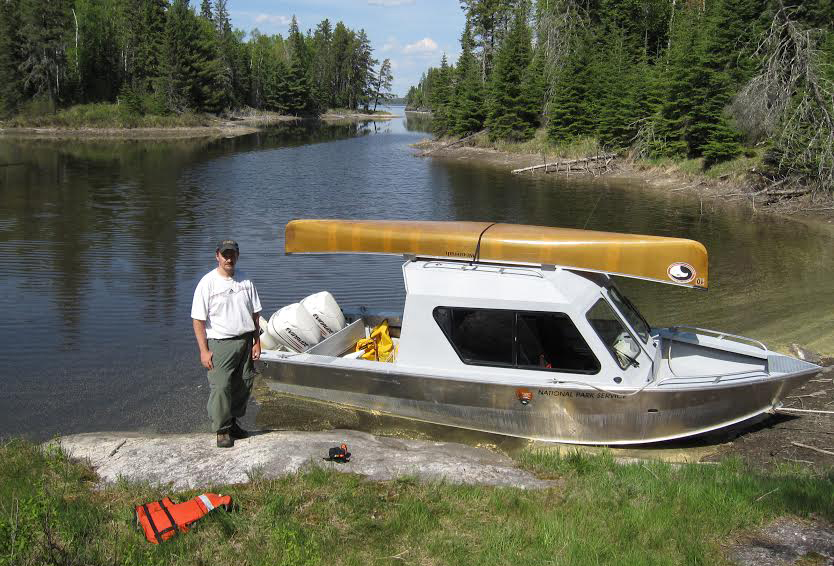Posted p.m. Tuesday, March 1, 2016

Grant-funded research to detect mercury contamination hot spots and high content areas.
 Kristofer Rolfhus, UWL professor of chemistry and biochemistry, hauling a sampling canoe into remote lakes in northern Minnesota.[/caption]
While mercury is released naturally into the environment, the vast majority comes from human activities such as fossil fuel combustion, mining and municipal waste, which are all inputs to this heavily industrialized region. The Environmental Protection Agency declared it an Area of Concern (AOC) — a geographic area where significant changes in the chemical, physical or biological integrity of the Great Lakes system is enough to cause issues such as fish tumors or deformities; degraded populations of wildlife; and restrictions on fish consumption; among other problems.
The grant-funded research aims to understand why fish have high mercury content in this area, as well as to identify where the mercury contamination hot spots are.
Rolfhus, Haro, and their UWL undergraduate researchers will receive about $76,000 of the total funds to explore whether mercury hot spots translate to high levels of mercury and methylmercury in the organisms that live there. They’ll collect water, snails, insects, and other "bio-indicating" creatures that live on top of the river sediment, and return to the lab to measure their concentrations.
Rolfhus initially became interested in studying mercury contamination as a UWL undergraduate student who graduated in 1991. A biology major and chemistry minor, he was helping now-retired UWL faculty members Ron Rada and James Wiener with research in some of the first comprehensive projects investigating mercury contamination in the Upper Midwest. He loved that he could take scientific research into the great outdoors while working on problems that make a difference for society.
Rolfhus hopes his own students get as much out of their research experience as he did. In addition to field work and learning chemical laboratory skills, students learn how to take very exact measurements of mercury concentrations using non-contaminating “clean techniques” as environmental levels are typically exceedingly low. Such care for detail is widely applicable to students interested in medical fields or other careers, says Rolfhus.
UWL is collaborating with UW-Madison, University of Minnesota-Duluth and Gustavus Adolphus College in Minnesota on the project.
Sea Grant
Conceived in 1966, Sea Grant is a national network of 33 university-based programs of research, outreach, and education for enhancing the practical use and conservation of coastal, ocean and Great Lakes resources to create a sustainable economy and environment. The National Sea Grant Network is a partnership of participating coastal states, private industry, and the National Sea Grant College Program, National Oceanic and Atmospheric Administration, U.S. Department of Commerce.
Kristofer Rolfhus, UWL professor of chemistry and biochemistry, hauling a sampling canoe into remote lakes in northern Minnesota.[/caption]
While mercury is released naturally into the environment, the vast majority comes from human activities such as fossil fuel combustion, mining and municipal waste, which are all inputs to this heavily industrialized region. The Environmental Protection Agency declared it an Area of Concern (AOC) — a geographic area where significant changes in the chemical, physical or biological integrity of the Great Lakes system is enough to cause issues such as fish tumors or deformities; degraded populations of wildlife; and restrictions on fish consumption; among other problems.
The grant-funded research aims to understand why fish have high mercury content in this area, as well as to identify where the mercury contamination hot spots are.
Rolfhus, Haro, and their UWL undergraduate researchers will receive about $76,000 of the total funds to explore whether mercury hot spots translate to high levels of mercury and methylmercury in the organisms that live there. They’ll collect water, snails, insects, and other "bio-indicating" creatures that live on top of the river sediment, and return to the lab to measure their concentrations.
Rolfhus initially became interested in studying mercury contamination as a UWL undergraduate student who graduated in 1991. A biology major and chemistry minor, he was helping now-retired UWL faculty members Ron Rada and James Wiener with research in some of the first comprehensive projects investigating mercury contamination in the Upper Midwest. He loved that he could take scientific research into the great outdoors while working on problems that make a difference for society.
Rolfhus hopes his own students get as much out of their research experience as he did. In addition to field work and learning chemical laboratory skills, students learn how to take very exact measurements of mercury concentrations using non-contaminating “clean techniques” as environmental levels are typically exceedingly low. Such care for detail is widely applicable to students interested in medical fields or other careers, says Rolfhus.
UWL is collaborating with UW-Madison, University of Minnesota-Duluth and Gustavus Adolphus College in Minnesota on the project.
Sea Grant
Conceived in 1966, Sea Grant is a national network of 33 university-based programs of research, outreach, and education for enhancing the practical use and conservation of coastal, ocean and Great Lakes resources to create a sustainable economy and environment. The National Sea Grant Network is a partnership of participating coastal states, private industry, and the National Sea Grant College Program, National Oceanic and Atmospheric Administration, U.S. Department of Commerce.